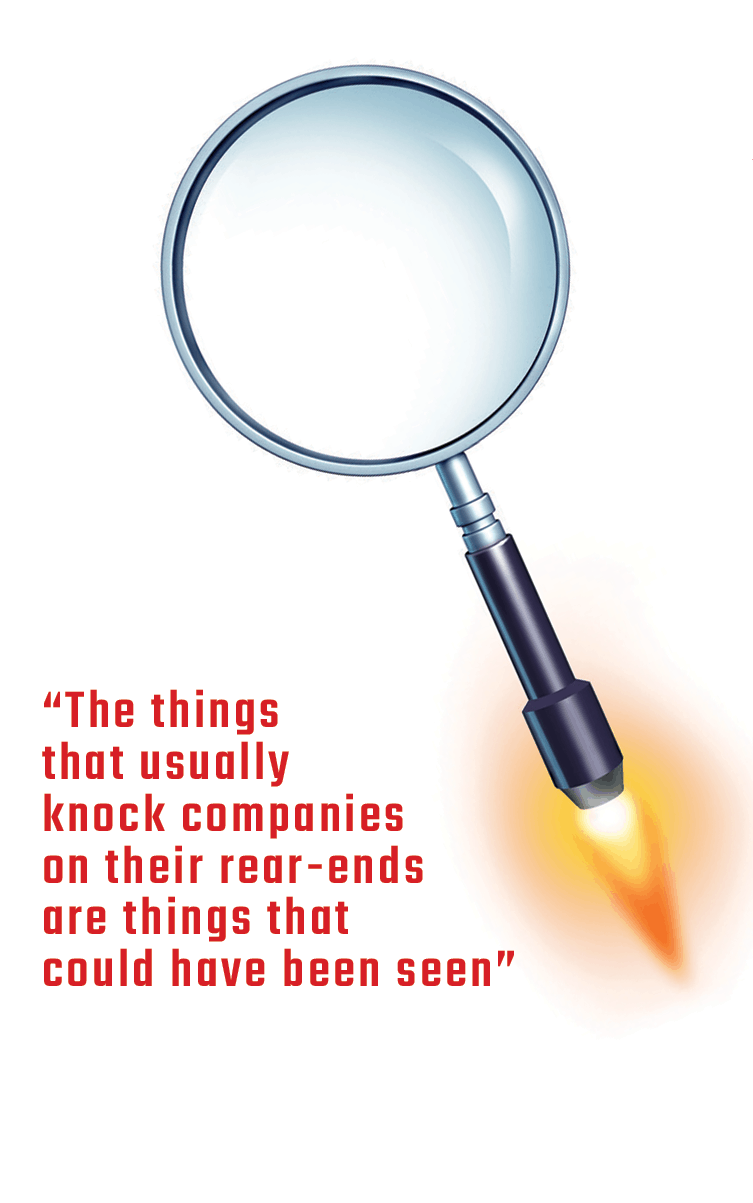Back in 2000, Reed Hastings tried to sell his then-struggling company to Blockbuster Video for a mere $50 million. Blockbuster had heard of Hasting’s company, Netflix, but it wasn’t buying the hype.
As a former high-ranking Blockbuster executive later noted, “Management and vision are two separate things.” The video delivery (and later streaming service) company was losing money and Blockbuster didn’t see the disruptive effect Netflix was about to have in the market.
The unrelenting fight to innovate, disrupt and lead your market is a formidable battle, full of opportunities that can make or break your business, as it did for Blockbuster. Neutralizing disruptive attacks from competitors or becoming a disruptor yourself requires planning beyond today—and even tomorrow.
Enter the Fray
Industry disruption has been a reality for most large companies for a while now, according to a 2018 Accenture study. An analysis of more than 3,600 companies found that disruption has a pattern that can be identified, understood, and prepared for—rather than being a random event beyond your company’s control.
Accenture developed an index that broke disruption down into its key components, which allowed them to position companies in 20 different industry sectors and 98 subsegments across four periods of disruption. The firm then identified steps companies could take to mitigate risk depending on where they fell on the index.
Durability
Companies need to reinvent their legacy business rather than focus on preserving it. That means maintaining cost leadership in the core business and making key offerings more relevant to customers (e.g., making offerings cheaper but better).
Vulnerability
Companies must make their legacy businesses more productive. This can position them to develop and leverage future innovations—both their own and their competitors. This could mean reducing dependency on mixed assets and monetizing underused assets.
Volatility
Companies must change the current course, radically transforming the core business while scaling new businesses.
Viability
Companies need to embrace a constant state of innovation, which involves increasing innovative offerings to existing customers while also aggressively expanding into adjacent or unchartered markets.
“Business leaders need to determine where their company is positioned in this disruption landscape and the likely speed of change,” said Omar Abbosh, Accenture’s chief strategy officer. “The more clearly they see what’s changing around them, the better they can predict and identify opportunities to create value from innovation for their business and rotate to the new.”
Accenture’s study asserts that in periods of rapid-fire change, companies need to deploy one of four strategies to act quickly: grow the core, transform the core, scale the new or pivot wisely.
So where can product professionals start in their quest to stave off unexpected disruption?
Complacency Breeds Vulnerability
When thinking about potentially disruptive changes, one of the best places to start is understanding what customers hate about you.
“There’s always something,” said Diane Pierson, PMC-VI, a Pragmatic Institute instructor with more than 20 years of experience in product management and marketing. “For Blockbuster, it was late fees. Legend has it that Reed Hastings started Netflix after fighting with his wife over a Blockbuster late fee. True? I don’t know. But everyone believes it could be.”
Pierson emphasized the importance of not dismissing the elements of your business that cause deep dissatisfaction simply because you’re the industry leader. This is where disruptors attack first. Vincent Lo, director of marketing insights and strategy at social media management platform Hootsuite, echoed Pierson’s comments.
“When users and end customers complain about a certain deficiency, there’s a lot of room for innovation and disruption,” he said. “Look at all the disruptions that have happened in the past five or 10 years and you notice that they all solve for that last-mile problem.”
The grocery business is a prime example of this. At its essence, it’s a logistics business: getting food from suppliers to customers. And no one solved the logistics of moving items from point A to point B like Amazon. Once it did that for shoes and electronics, there was no reason it couldn’t expand and build on this differentiator in other markets.
“Amazon created one of the most enviable supply chains on the planet, and now it doesn’t matter what they distribute,” said Michael Smart, PMC-V, founder and managing principal of Egress Solutions Inc. “Pick your local grocery store; could it have seen the impending impact of Amazon 15 years ago? The answer is ‘yes.’”
Insurance is another industry that’s ripe for disruption due to general customer dissatisfaction. No one buys insurance because it’s the best product available, or the best solution—they buy it because they have to have it.
“When you see reviews and customer sentiments that people are buying (a product or service) to fill a need or gap rather than because the products they have are moving forward in that space, that’s where I think the disruption is,” said David Washer, a competitive intelligence expert at competitive intelligence firm Klue.
Look Beyond the Obvious
Entrepreneur Corey Brundage has started five different companies, and with each new venture, he’s tried to understand the demand side of the market. His most recent company, HONK, enables users to find and order roadside assistance from a browser, phone or tablet, without a membership fee. The company’s beginning was influenced by two factors, one public and one personal.
When Uber’s financials were leaked in 2015, the market was first exposed to how disruptive the car service company really was. “It was too late for the taxi industry to do anything,” Brundage recalled, but he added that the information about Uber’s number of users, the volume they were doing, and how quickly the business was growing was interesting to people looking at new models in the on-demand and technology-enablement space—particularly as it applied to the service industry.
Then, about six months later, Brundage and his fiancée had a car breakdown that left them without a vehicle for two days—just because of a simple dead battery. He wondered why there wasn’t an app they could have tapped into for roadside assistance. That personal experience, coupled with his thoughts around on-demand services, led to the birth of HONK.
“Sometimes something as simple as one company having an edge in a market and getting some of their data out there can be a pretty big force in terms of disruption, even across other industries,” Brundage said.
Similarly, when thinking about opportunities to disrupt or the potential to be disrupted, product professionals should look beyond their markets.
“Look at the outside,” Lo said. “Look at adjacent markets, how other industries could be potentially disrupted, and—when they are disrupted—how it will affect you.”
Keep Your Ear to the Ground
Just because a company produces something new or different doesn’t guarantee success. “You have to know there are a ton of failures before something works and something catches,” Washer said. “The market has to be there, the product has to be there, and they both have to be there at the same time.”
Identifying the right time and product requires testing, and it always comes back to consumer feedback. Washer has several questions that he asks clients when helping them build their battle cards, including what you hear people talking about.
He offered the words “big data” as an example—a term virtually unknown when it emerged in 2005, but relatively universal today. Washer also said key data points come in the form of unstructured data: words and sentiments in social media posts and online communities, for example.
“That’s where the big challenge of this exercise comes in,” he said. “It’s the tweets—how do you flag what no one else has seen yet? We’ll find key leaders in industry and watch them. If they’re talking about it, odds are we’ll be hearing about it sometime soon.”
Lo said that, beyond individual keywords, scenarios in the social space also provide an opportunity. When social scenarios start with “I wish there was a …” or “What if …”, those are indicators of a larger situation—and areas that are ripe for disruption. Customers are outlining scenarios in which no one is satisfying a need.
Build Your Tech Allies
To survive and thrive in a disrupted industry, companies need to transform and develop their core business while at the same time innovating to create and scale new business, according to Mike Sutcliff, group chief executive of Accenture digital.
“Embracing digital is part of it. We found that the lower an industry’s digital performance, the more susceptible it is to future disruption,” he said. “Digital technologies can help make a company more resilient in times of disruption in a number of ways, whether by driving better outcomes from existing products, developing entirely new digital services, lowering costs or increasing barriers to entry.”
Brundage believes data will play a critical role in identifying potential disruptions—but it’s still in a developing stage.
“I think most businesses have keyed in on the fact that they need to create hypotheses, validate those and let the customer ride in the passenger seat in the definition and development of products, and most people are doing that,” Brundage said. “But what becomes really interesting is things like A/B testing. In a lot of scenarios, it doesn’t work and you’re probably making decisions based on bad data. Some of the elements that are coming out of data science are going to solve those problems.”
This is a particularly high hurdle that most companies are still trying to jump. While many companies gather a lot of market research, few are effectively aggregating or communicating what they learn to deliver actionable insights.
“Most companies could improve their competitive position—not to mention their top- and bottom-line performance, customer satisfaction, and employee morale,” Pierson said. “They can do this by identifying the sources of valuable market knowledge and working with a data science team to gather, aggregate, and prioritize.”
Hone Your Competitive Intelligence
To keep tabs on competitors, seemingly minor indicators can show if a rival is about to make an industry-shaking change:
- Job openings give a view into the roles a company is trying to fill and how it describes the work that needs to be done. You get a glimpse into your competitors’ priorities and what they’re thinking from a vision perspective.
- Online employer review sites like Glassdoor.com provide insights into areas of opportunity. Disgruntled employees share company challenges, customer complaints, and how the company is investing or shifting.
- Website monitoring tools can reveal what the competition is testing and what it carries forward.
- Social monitoring of specific events, like marketing and technology conferences, can be useful. Lo explained that when you see trends or clusters of certain ideas at these types of events, you’ll see the output three, six, or 12 months later.
- The words a competitor uses also can hint at a coming change. Washer said CEO speeches and SlideShares from conferences are good tip-offs, as CEOs often talk about changes before they’re a common theme. When you hear them using a different language, it’s likely something is coming, and that’s possibly a new market opportunity.
Winning the Disruption War
Innovation and disruption aren’t new threats, but they are moving faster. Rather than waiting to see what happens, product professionals should take steps to not only beat potential disruptors at the front gate but also consider what it will take to become a market or industry disruptor. And this takes time, dedication, and an ability to think differently.
“The things that usually knock companies on their rear ends are things that could have been seen,” said Smart, who was also a principal consultant for Pragmatic Institute from 2007 to 2009. “They’re the things that, as really high-performing product people, we should be chipping away at. But you never ‘solve’ it. It never stops needing to be done.”
Author
-

Andrea Ozias, a seasoned professional with 27 years in senior communications, editorial, and marketing roles, has contributed her expertise to WorldatWork, The Kansas City Star, and Phoenix Business Journal. Known for high expectations, hard work, dedication, and loyalty, Andrea continues to excel in her commitment to excellence. Having made significant contributions at Pragmatic Institute, Ozias Editorial Services LLC, and WTW, she is a valuable asset in her field. For questions or inquiries, please contact [email protected].
View all posts










